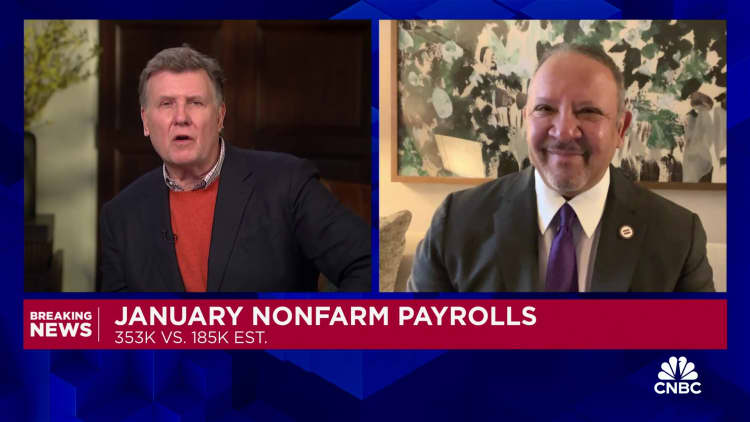
U.S. economy added 353,000 jobs in January, much better than expected

Job growth posted a surprisingly strong increase in January, demonstrating again that the U.S. labor market is solid and poised to support broader economic growth.
Nonfarm payrolls expanded by 353,000 for the month, much better than the Dow Jones estimate for 185,000, the Labor Department’s Bureau of Labor Statistics reported Friday. The unemployment rate held at 3.7%, against the estimate for 3.8%.
Wage growth also showed strength, as average hourly earnings increased 0.6%, double the monthly estimate. On a year-over-year basis, wages jumped 4.5%, well above the 4.1% forecast. The wage gains came amid a decline in average hours worked, down to 34.1, or 0.2 hour lower for the month.
Job growth was widespread on the month, led by professional and business services with 74,000. Other significant contributors included health care (70,000), retail trade (45,000), government (36,000), social assistance (30,000) and manufacturing (23,000).
“This just reaffirms that the jobs market is entering 2024 on solid ground,” said Daniel Zhao, lead economist at Glassdoor. “The fact that job growth was so widespread across industries is a healthy sign. Coming into today’s report, we were concerned about how concentrated jobs were in really just three sectors — health care, education and government. While it is great to see those sectors drive job gains, there was no guarantee that would be enough to support a health labor market.”
The report also indicated that December’s job gains were much better than originally reported. The month posted a gain of 333,000, which was an upward revision of 117,000 from the initial estimate. November also was revised up, to 182,000, or 9,000 higher than the last estimate.
DON’T MISS: The ultimate guide to acing your interview and landing your dream job
While the report demonstrated the resilience of the U.S. economy, it also could raise questions about how soon the Federal Reserve will be able to lower interest rates.
“Make no mistake, this was a blowout jobs report and will vindicate the recent posturing by the Fed which effectively ruled out an interest rate cut in March,” said George Mateyo, chief investment officer at Key Private Bank. “Moreover, strong job gains combined with faster than expected wage gains may suggest an additional delay in rate cuts for 2024 and should cause some market participants to recalibrate their thinking.”
Futures markets shifted after the report, with traders now pricing in a better than 80% chance that the Fed does not cut interest rates at its March meeting, according to the CME Group.
Stocks were mixed following the report. The Dow Jones Industrial Average dropped at the open but the S&P 500 and Nasdaq both were positive. Treasury yields surged.
The January payrolls count comes with economists and policymakers closely watching employment figures for direction on the larger economy. Some high-profile layoffs recently have raised questions about the durability of what has been a powerful trend in hiring.
A more encompassing measure of unemployment that includes discouraged workers and those holding part-time jobs for economic reasons edged higher to 7.2%. The household survey, which measures the number of people actually holding jobs, differed sharply from the establishment survey, showing a decline of 31,000 on the month. The labor force participation rate was unchanged at 62.5%.
One potentially important caveat in the report could be the divergence between average hourly earnings and hours worked. Retail trade saw a fresh historical low of 29.1 hour in data going back to March 2006.
“This suggests that employers chose to reduce hours rather than resort to layoffs for the moment,” the Conference Board said in a report analysis.
Broader layoff numbers, such as the Labor Department’s weekly report on initial jobless claims, show companies hesitant to part with workers in such a tight labor market.
Gross domestic product growth also has defied expectations.
The fourth quarter saw GDP increase at a strong 3.3% annualized pace, closing out a year in which the economy defied widespread predictions for a recession. Growth in 2023 came even as the Fed further raised interest rates in its quest to bring down inflation.
The Atlanta Fed’s GDPNow tracker is pointing toward a 4.2% gain in the first quarter of 2024, albeit with limited data of where things are heading for the first three months of the year.
The economic, employment and inflation dynamics make for a complicated picture as the Fed seeks to ease monetary policy. Earlier this week, the Fed again held benchmark short-term borrowing costs steady and indicated that rate cuts could be ahead but not until inflation shows further signs of cooling.

Chair Jerome Powell indicated in his post-meeting news conference that the central bank does not have a “growth mandate” and said central bankers remain concerned about the impact that high inflation is having on consumers, particularly those on the lower end of the income scale.
Outside of the wage numbers, recent data is showing that inflation is moving in the right direction.
Core inflation as measured by personal consumption expenditures prices was just 2.9% in December on a year-over-year basis, while six- and three-month gauges both indicated the Fed is at or around its 2% goal.
Still, the Atlanta Fed’s measure of “sticky” inflation, which focuses on items such as housing, medical care services and insurance costs, was at 4.6% on a 12-month basis in December.
Don’t miss these stories from CNBC PRO:
- Forget the ‘Magnificent 7,’ these Nasdaq stocks are next in line to lead the rally, according to the charts
- Nvidia is now ‘deeply overbought’ and due for ‘consolidation,’ says chart analyst
- Eli Lilly’s Zepbound is off to a strong start, but here’s what needs to happen to push shares higher
- Investors are shifting into this type of bond fund at the fastest pace in three years
